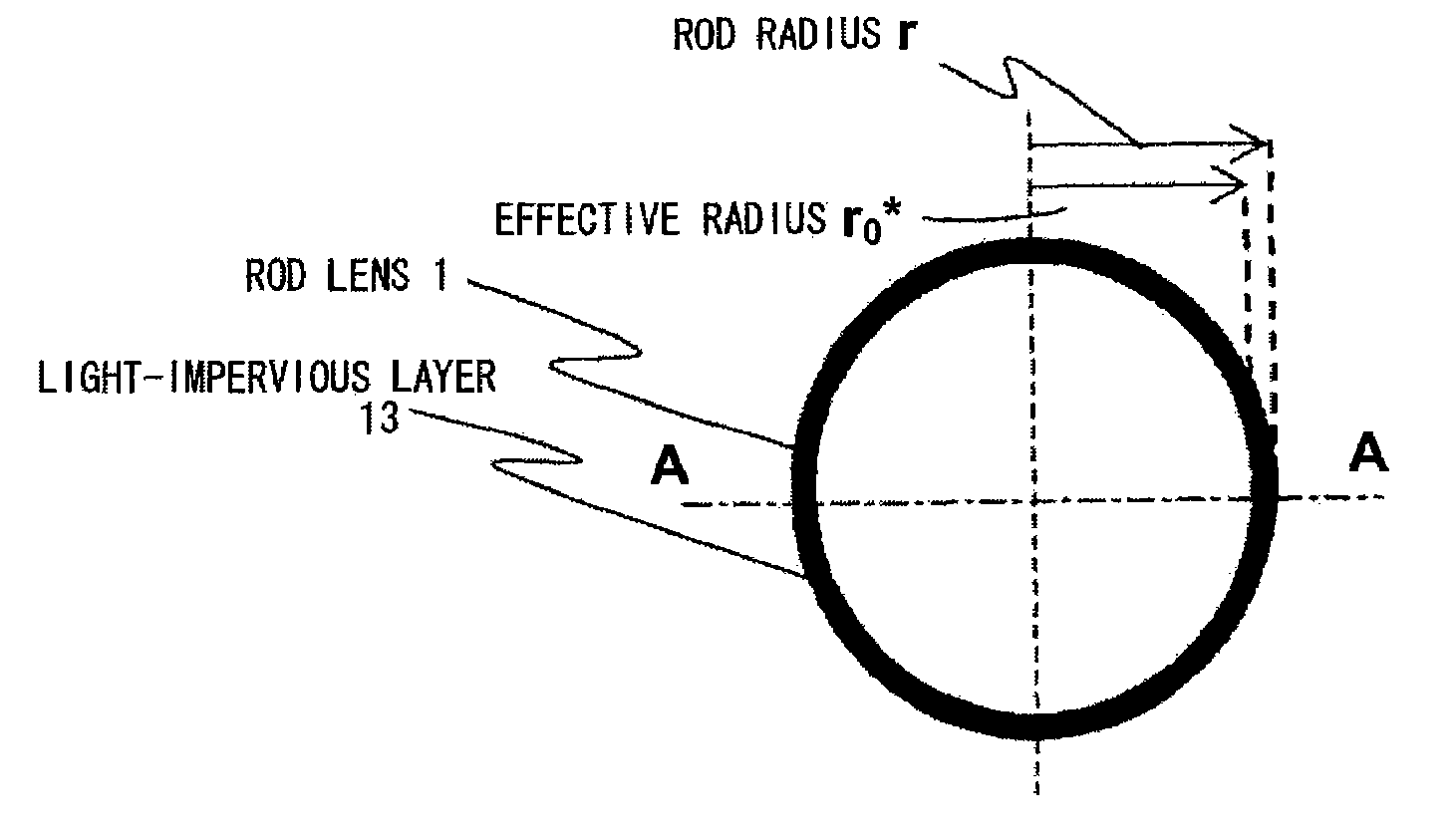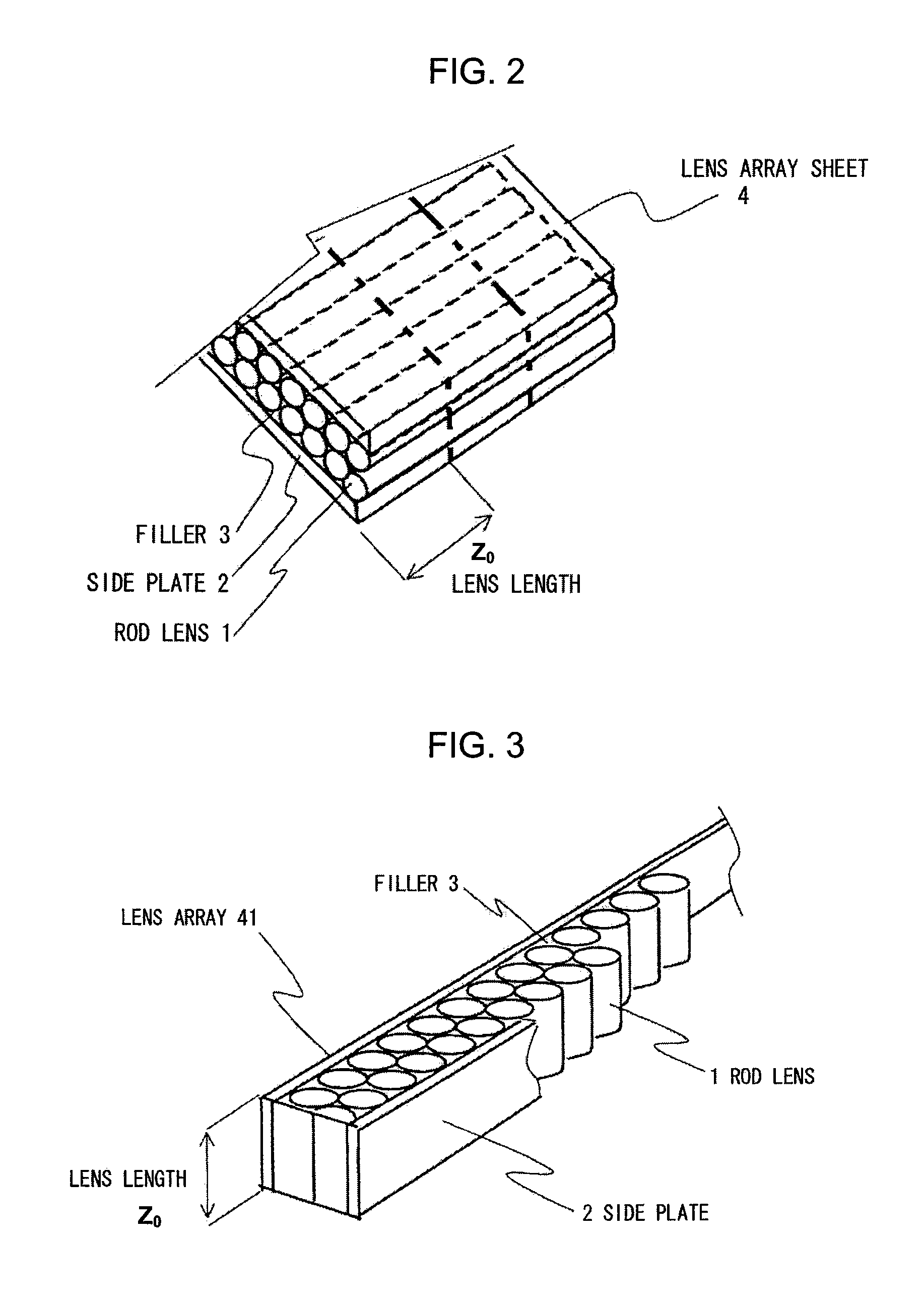Lens array, exposure device, and image forming apparatus
a technology which is applied in the field of exposure device and exposure array, can solve the problems of insufficient contrast between a bright section and a dark section of the exposure image, difficult to form the light absorbing layer, and deterioration of optical characteristics, so as to prevent the adverse effect of the fluctuation part on the optical characteristics, improve the resolution, and improve the contrast
- Summary
- Abstract
- Description
- Claims
- Application Information
AI Technical Summary
Benefits of technology
Problems solved by technology
Method used
Image
Examples
first embodiment
[0033]A lens array according to a first embodiment of this invention will be explained with reference to drawings. FIG. 1 is a perspective view showing a rod lens composing the lens array according to this embodiment. The lens array according to this embodiment adopts the rod lens that is formed by processing glass. For example, a rod lens made from glass is formed by a direct spinning method (continuous spinning method). In the method for forming the lens array, first, the glass is melted and shaped by the spinning method, thereby the glass being cut into a predetermined size. The glass fiber, which was cut out, is then subject to an ion-exchange process to form a refractive-index distribution, thereby becoming a rod lens 10 of radius r. The rod lens is then subject to an etching process to remove a portion of the outer periphery 10 to form a radius of r0. Subsequently, a side surface 11 of the rod lens is subject to a roughening process and coated with a black dye. The plurality o...
second embodiment
[0066]A structure of the lens array according to a second embodiment will be explained next. FIGS. 13 and 14 are schematic views of a lens array. In a manner similar to the lens array according to the first embodiment, the lens array is formed such that a refractive-index distribution is formed from a central axis to an outer periphery, in which the rod lenses 1 having been subject to the process for making the side surfaces thereof absorb the light beam from the luminous source are arrayed in one or more lines between two side plates 2. The filler 3 is filled into gaps and hardened to form the lens array.
[0067]The distances Lo between the luminous light source and the one end of rod lens and Li, the distance from the imaging surface to a second end of the rod lens in FIG. 14 are adjusted to set Li=Lo=Lf on the condition that a focal length of the lens array 41 is set to be Lf. A distance TC is a conjugation length of the lens array 41, which is a distance between a surface of an ob...
third embodiment
[0084]A structure of the lens array according to the third embodiment will be described next. The third embodiment has the same structure as that of the second embodiment in that there is such a relation as expressed by the following Equation 3 between the effective radius r1 [mm] of a portion of the rod lens 1, through which the light beam from the luminous source passes, and the conjugation length TC [mm] which is a distance between the object face of the lens array 41, as shown in drawings, and the imaging surface.
r1≦0.015 TC+0.113 [Equation 3]
[0085]Furthermore, with respect to the conjugation length TC [mm] in the lens array 41, there is such a relation as expressed by the following Equation 6.
9.100≦TC≦15.100 [Equation 6]
[0086]The exposure device and the image forming apparatus according to this embodiment have the same structure as those of the second embodiment in that there is such a relation as expressed by Equation 7 between the effective radius r1 of the rod lens 1 as sh...
PUM
 Login to View More
Login to View More Abstract
Description
Claims
Application Information
 Login to View More
Login to View More - R&D
- Intellectual Property
- Life Sciences
- Materials
- Tech Scout
- Unparalleled Data Quality
- Higher Quality Content
- 60% Fewer Hallucinations
Browse by: Latest US Patents, China's latest patents, Technical Efficacy Thesaurus, Application Domain, Technology Topic, Popular Technical Reports.
© 2025 PatSnap. All rights reserved.Legal|Privacy policy|Modern Slavery Act Transparency Statement|Sitemap|About US| Contact US: help@patsnap.com



